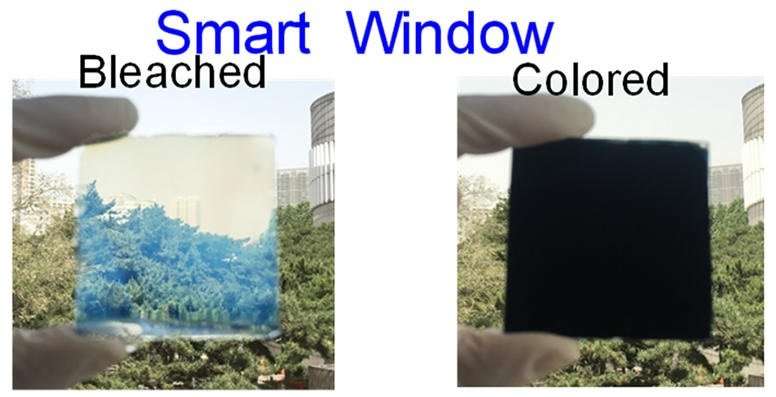July 13, 2018 feature
Smart window controls light and heat, kills microorganisms

A new smart window offers more than just a nice view—it also controls the transmittance of sunlight, heats the interiors of buildings by converting solar radiation into heat, and virtually eliminates E. coli bacteria living on the glass. In the future, such sterile smart windows may be used in airplanes, hospitals, public transportation, and other areas.
The researchers, led by Yan-Yan Song at Northeastern University in Shenyang, China, and Xing-Hua Xia at Nanjing University in Nanjing, China, have published a paper on the new sterile smart window in a recent issue of ACS Nano.
As the researchers explain, integrating multiple functions into a single smart window presents a challenge, since each function typically requires a different material composition. For example, one of the most widely used materials for smart windows that control visible light transmission is WO3 (tungsten trioxide). As an electrochromic material, WO3 can reversibly change its optical transmittance in response to electrochemical charging and discharging. On the other hand, smart windows that convert near-infrared solar radiation into heat typically involve metal nanoparticles. Also, a wide range of materials have antimicrobial properties, most notably copper. So far, however, combining all of these properties into one material has remained a challenge.
In the new study, the researchers designed an electrochromic-photothermal film composed of 3D WO3 in a honeycomb-like structure embedded with gold nanoparticles and nanorods. While the WO3 controls the amount of visible light that passes through the window, the gold nanostructures convert incoming sunlight into thermal energy for heating the building interior.
"This is a new strategy that achieves excellent photothermal conversion via solar gain optimization on electrochromic films and, importantly, the photothermal efficiency is adjustable during optical transmission," Xia told Phys.org.
The researchers demonstrated that the window can change from fully transparent to pitch black within minutes. Further, they showed that a near-infrared laser increases the temperature of the window by 24 °C in about five minutes. To investigate the antimicrobial properties of the window, the researchers treated it with E. coli and irradiated it with a near-infrared laser. They found that the bactericidal effect was strongest when the window was in its dark state, in which it could eliminate virtually all of the bacteria. In contrast, the effect was much weaker for windows in the transparent state, as well as those made of only WO3 or only gold nanostructures, rather than both materials combined. The results suggest that most of the bactericidal effects are due to the photothermal properties of the window.
"The sterile smart window would be particularly useful in aircraft, in high-latitude zones, and also in hospitals," Xia said. "It should be multifunctional, for example, controlling visible light transmission dynamically, tuning heat conversion of near-infrared solar radiation, and reducing attacks by microorganisms."
More information: Jingwen Xu et al. "Electrochromic-Tuned Plasmonics for Photothermal Sterile Window." ACS Nano. DOI: 10.1021/acsnano.8b02292
Journal information: ACS Nano
© 2018 Phys.org





















